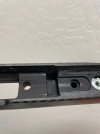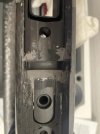When the recoil lug is involved in using bedding compound.
Check the recoil lug very careful, Measure thickness and width very carefully. Make sure there is a taper from barrel to bottom of lug.
both width and thickness, And no burrs on corners. If needed, Remove excess metal from sides and front (barrel side) of lug. Even with release agent, The barrel lug can become a mechanical lock in the bedding compound. And what a revolting development this is.
I like to put a couple layers of masking tape on the bottom of the lug, So the lug will have a little free space when the action screws are torqued down.


